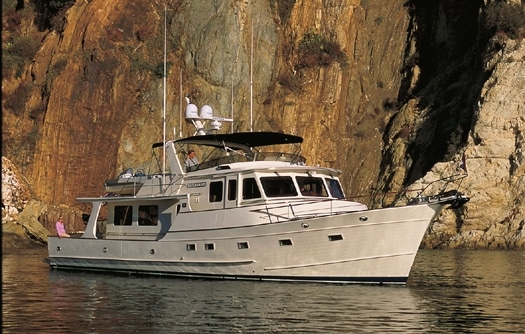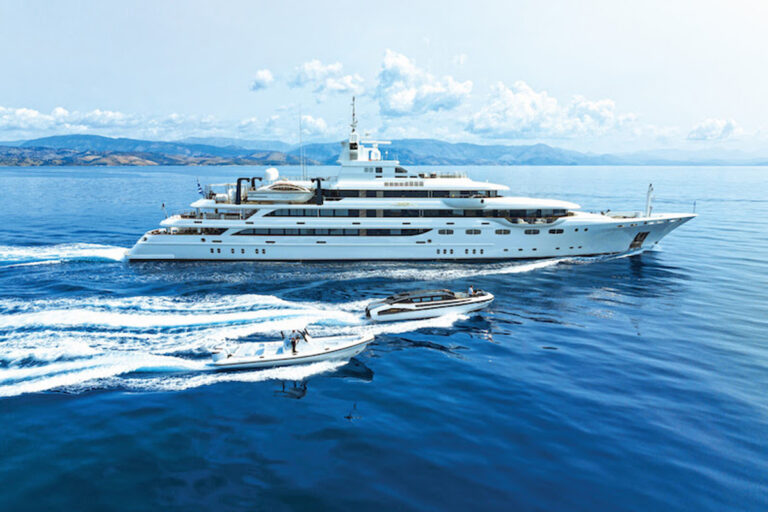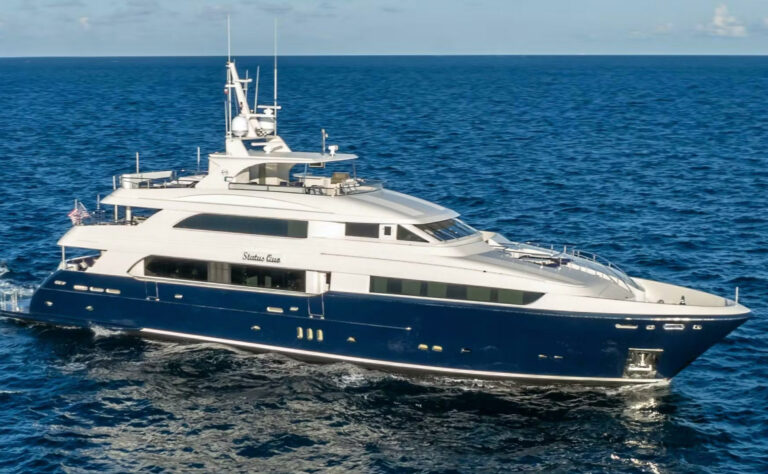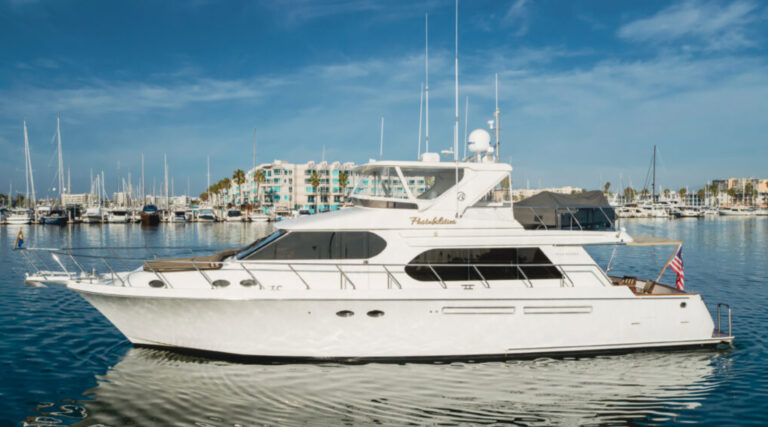
Fleming 65
“I’m not in this business to build an empire,” protests Tony Fleming, with a wry smile. And yet, with 189 of his Fleming 55 trawler yachts sold since production began just 20 years ago, the numbers belie his modesty.
After the overwhelming acceptance of its first offering, Fleming Yachts brought out a 75-footer that has proven to be equally popular. But the boatbuilder also discovered that a 20-foot jump in size was a bit much for some owners. To fill that gap, the Fleming 65 was born.
While the earlier two boats were designed by Larry Drake with styling by Tony Fleming, the 65 is a Doug Sharp design with entirely new hull lines. It still has the long keel of the other Flemings, but the 65 flattens aft for improved speed and stability, while prop pockets keep the draft to just five feet for island cruising. On a windy and rough trip down the Pacific Coast, the first 65 hit 20 knots while surfing some of the big seas. That was far beyond her 11-knot cruising speed, yet she tracked straight with fingertip control on the wheel.
Upping the length from 55 feet to 65 provides far more than just a few dimes’ worth of difference: The beam increases by more than two feet and the displacement soars from around 66,000 pounds to 108,000 pounds. Most important, however, is how the interior volume increases geometrically to create a spacious three-stateroom layout with liveaboard space.
From the outside, the new 65 won’t disappoint Fleming aficionados, who will see at a glance that the styling cues haven’t been lost in the designer transition. The boat still looks long and lean on the water, mostly because the foredeck is surrounded by teak-capped rails rather than the solid raised bulwarks that give some trawlers a bluff-bowed appearance. Here the Portuguese bridge remains forward of the pilothouse, while the wide side decks are protected by the overhang of the bridge (good for sun protection in the tropics as well as from rain in northern climes). The sheerline curves sweetly from bow to stern.
Inside, the design brief was for more comfort, sensibly achieved. Rather than trying to shoehorn in additional cabins, the three staterooms have been enlarged to the size of those on much larger yachts. A day head is in the pilothouse. The owner’s cabin is forward, with a queen-sized berth that hinges up on gas lifts to reveal a king-sized storage bin underneath. Two hanging lockers have real-world dimensions so that clothing actually hangs on the hangers rather than simply being wedged in vertically; ample drawers create bureaus for smaller clothing-room enough for a major clothes horse.
Distinguishing the 65, as with other Flemings, are the clever solutions to problems often overlooked or simply swept under the table by other builders. Because the Fleming 65 will be offered in Europe, it must meet CE safety requirements that emergency exits be nearby in each stateroom. To solve the problem, Tony Fleming devised the lighted ceiling treatment in the owner’s stateroom so that it hinges down to reveal not only a deck hatch, but a fold-out ladder as well.
The master head is comfortably sized and has a large stall shower with a Corian deck grating and Headhunter pressure-jet toilets, which are standard throughout.
The port guest cabin has twin berths (a queen is optional), plus a Pullman fold-down on the inboard bulkhead and a stretcher-bar berth over the outboard berth. Across the companionway is the guest head with another large shower, with a seat for added functionality.
Several arrangements are available for the starboard cabin, but our 65 had one that Tony believes is likely to be the most popular: a pair of criss-crossed upper/lower berths. The lower berth can be used as a settee, and there’s a desk on the forward bulkhead large enough to serve as an onboard office complete with computer.
The real living areas on the Fleming 65 are likely to be the saloon and pilothouse. Though separated by the galley bulkhead, these seem to flow into one large space. The saloon has a settee to starboard with a table that unfolds to become a dining table. A pair of Tony Fleming-designed swivel bucket chairs also serve as table seating, and a pair of Fleming-designed hassocks conceal large storage bins as well. A 37-inch Sharp Aquos TV pops up on an Inca swivel lift from a cabinet in the after corner, while a wet bar with a fridge is to port.
Our test boat was hull #1; it was being kept by Fleming as a demonstrator and to allow the company to try out new systems and equipment. In the galley, which fills the forward end of the saloon, is an unusual Brandt four-burner induction cooktop. Not only does it heat without heat (you can put your hand on the burners!) for safety at sea, but it also works very quickly: A pot of cold water boils in under two minutes.
The pilothouse is likely to be the gathering spot while underway, with a curved settee to port, a custom pedestal chair behind the helm, and an expanse of black dashboard that would be a challenge to fill with electronics. With big windows, the visibility is superb, but late-afternoon sun glare can be an issue. The solution is a set of pull-down blinds to shade the crew while imparting a 1940s film noir touch to the proceedings.
The large day head to starboard is a welcome addition, and future 65s will have a wet locker for foul-weather gear as well, since the crew will be coming and going in all conditions through the two sliding doors on each side of the pilothouse. Another thoughtful inclusion is the chart table built into the starboard side of the dashboard, since savvy skippers still use paper charts to back up their occasionally fallible chart plotters. There also are drawers to handle those charts underneath.
The flying bridge is just steps from the pilothouse, with a raised platform for the port-side helm to give the skipper a clear view of the bow. Just aft of the helm is a built-in barbecue with an undercounter fridge, and a huge Glacier freezer that will handle the frozen food for weeks of cruising. To starboard is a comfortable J-shaped settee. A Bimini top that uses a hinged fiberglass radar arch as a primary support, as well as for storage, protects the entire area.
Aft, the boat deck is as solid as a concrete sidewalk, and easily holds a 14-foot Zodiac tender on fore-and-aft fiberglass ribs. Key to this rigidity are the cradles, which are really aluminum weldments molded into the deck to create sturdy cantilevers that support the tender. A 1,500-pound Steelhead crane launches both tender and watertoys.
Standard power is a pair of Cummins QSM11 660 hp diesels (CATS to 1,000 hp are available options) in a spacious engineroom that has nearly full headroom, thanks to the clever use of space in the wide bilge area of the keel. Full-beam fiberglass tanks plus a pair of auxiliary tanks store 1,700 gallons of fuel, and a tidy manifold system allows for fuel transfer. With long-range roaming in mind, this 65 has a Sepa fuel polisher as well.
The standard Fleming 65 has an Onan 21.5kW genset, but Tony Fleming decided to tinker a bit with our test boat since he likes quiet while at anchor. A Mastervolt system of four 2,500w inverters plus banks of 1,100-amp-hour batteries provide silent power for the majority of the systems. Most unusual, however, is the Sterling external combustion generator, which provides AC power at the sound level of a sewing machine. External combustion engines, which were used on the space shuttle, are too complicated to explain here (go to www.howstuffworks.com), but make perfect sense in this usage.
Underway, the Fleming 65 was a delight. We topped out at nearly 17 knots, but 1,600 rpm give somewhere around 11.5 knots, a comfortable ride in most seas, and long-legged range. With bow and stern Sidepower thrusters, she was much more nimble in close quarters than you’d expect from her fiftyish tons, but all that weight and her hull shape give her a comfortable motion at sea, too.
Tony Fleming may say he has no plans for an empire but, with the Fleming 65 already sold out through 2009, his fans may build one for him.
Contact: Fleming Yachts, (949) 723-4225; www.flemingyachts.com









